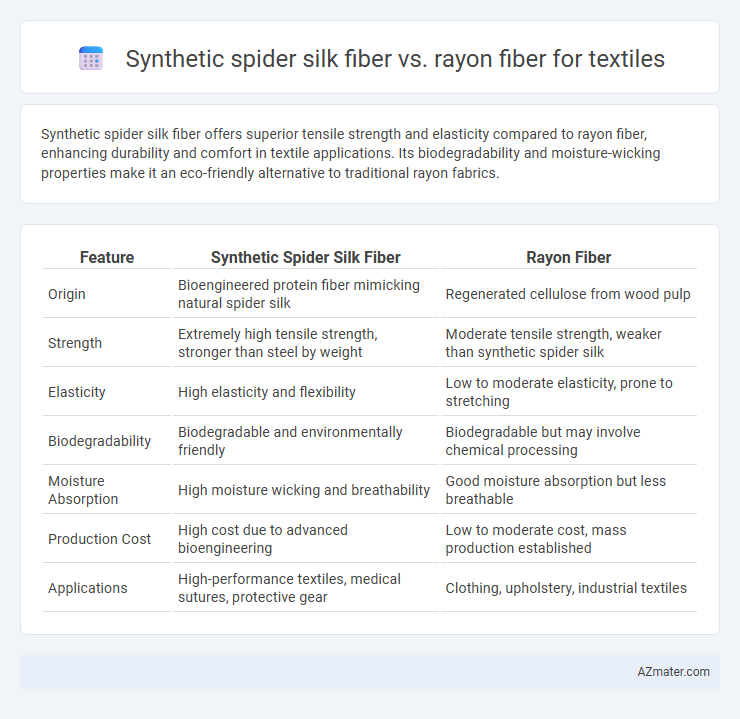Synthetic spider silk fiber offers superior tensile strength and elasticity compared to rayon fiber, enhancing durability and comfort in textile applications. Its biodegradability and moisture-wicking properties make it an eco-friendly alternative to traditional rayon fabrics.
Table of Comparison
| Feature | Synthetic Spider Silk Fiber | Rayon Fiber |
|---|---|---|
| Origin | Bioengineered protein fiber mimicking natural spider silk | Regenerated cellulose from wood pulp |
| Strength | Extremely high tensile strength, stronger than steel by weight | Moderate tensile strength, weaker than synthetic spider silk |
| Elasticity | High elasticity and flexibility | Low to moderate elasticity, prone to stretching |
| Biodegradability | Biodegradable and environmentally friendly | Biodegradable but may involve chemical processing |
| Moisture Absorption | High moisture wicking and breathability | Good moisture absorption but less breathable |
| Production Cost | High cost due to advanced bioengineering | Low to moderate cost, mass production established |
| Applications | High-performance textiles, medical sutures, protective gear | Clothing, upholstery, industrial textiles |
Introduction to Synthetic Spider Silk and Rayon Fibers
Synthetic spider silk fiber, engineered to replicate the extraordinary strength, elasticity, and biodegradability of natural spider silk, offers remarkable potential for textile applications requiring high-performance materials. Rayon fiber, derived from regenerated cellulose, is widely used for its softness, breathability, and cost-effectiveness, making it a popular choice in fashion and home textiles. While synthetic spider silk emphasizes advanced mechanical properties and sustainability, rayon fibers prioritize comfort and affordability, catering to different textile market demands.
Origin and Production Processes
Synthetic spider silk fiber is engineered using bioengineered proteins that mimic the natural silk produced by spiders through genetic modification and recombinant DNA technology, allowing for scalable and environmentally friendly production in controlled bioreactors. Rayon fiber, derived from cellulose extracted primarily from wood pulp, undergoes chemical processing including the viscose or lyocell methods, where cellulose is dissolved and regenerated into fibers through chemical treatment and spinning. The production of synthetic spider silk fibers emphasizes biomimicry and sustainable biotechnology, whereas rayon relies on traditional cellulose extraction and chemical regeneration, impacting the environmental footprint and mechanical properties of each textile fiber.
Molecular Structure Comparison
Synthetic spider silk fiber exhibits a unique molecular structure characterized by highly repetitive protein sequences forming beta-sheet nanocrystals interconnected by amorphous regions, providing exceptional tensile strength and elasticity. Rayon fiber, derived from regenerated cellulose, consists primarily of linear chains of glucose molecules forming semicrystalline regions with hydrogen bonding that contributes to its moderate strength and moisture absorbency. The molecular arrangement in synthetic spider silk allows for superior durability and flexibility compared to the more brittle and hydrophilic nature of rayon fiber in textile applications.
Mechanical Properties: Strength and Flexibility
Synthetic spider silk fiber exhibits superior mechanical properties compared to rayon fiber, with tensile strength reaching up to 1.3 GPa, significantly higher than rayon's average strength of 0.4-0.6 GPa. Its remarkable flexibility and elasticity allow extension up to 35%, outperforming rayon's more brittle nature and limited elongation of around 10%. This combination of high strength and flexibility makes synthetic spider silk fiber an ideal choice for advanced textile applications requiring durability and comfort.
Environmental Impact and Sustainability
Synthetic spider silk fiber demonstrates superior environmental sustainability compared to rayon fiber, as it is produced through bioengineered processes requiring less water and fewer chemicals. Rayon fiber, derived from cellulose treated with toxic solvents, contributes to significant deforestation and pollution in manufacturing. The biodegradability and renewable sourcing of synthetic spider silk reduce ecological footprint, making it a more sustainable alternative in textile production.
Biocompatibility and Safety
Synthetic spider silk fiber offers superior biocompatibility compared to rayon fiber, making it highly suitable for medical textiles and wearable applications. Its protein-based structure mimics natural silk, reducing the risk of allergic reactions and skin irritation often associated with rayon's viscose cellulose derivation. Enhanced biodegradability and non-toxic production further position synthetic spider silk as a safer alternative in sustainable textile manufacturing.
Cost of Production and Scalability
Synthetic spider silk fiber offers high tensile strength and elasticity, but its production cost remains significantly higher than rayon fiber due to complex bioengineering and fermentation processes. Rayon fiber benefits from established large-scale manufacturing techniques using cellulose, resulting in lower production costs and greater scalability for textile applications. The scalability of synthetic spider silk is limited by bioreactor capacity and purification challenges, whereas rayon's raw material abundance and established supply chains enable mass production at competitive prices.
Applications in Textile Industry
Synthetic spider silk fiber offers exceptional tensile strength, elasticity, and biodegradability, making it ideal for high-performance textile applications such as sportswear, medical sutures, and protective clothing. Rayon fiber, derived from cellulose, is widely used for its softness, breathability, and cost-effectiveness in everyday garments, upholstery, and home textiles. The textile industry leverages synthetic spider silk for innovative, durable, and sustainable products, while rayon remains favored for affordable, versatile fabric solutions.
Performance in Fabric and Garment Use
Synthetic spider silk fiber outperforms rayon fiber in tensile strength, elasticity, and moisture management, making it highly durable and comfortable for textile applications. Its superior biodegradability and UV resistance ensure prolonged fabric life and environmental sustainability compared to rayon, which often degrades faster and lacks resilience. Garments made from synthetic spider silk exhibit enhanced softness, breathability, and wrinkle resistance, providing better wearability and maintenance than rayon-based textiles.
Future Trends and Innovations
Synthetic spider silk fiber offers exceptional tensile strength, biodegradability, and moisture-wicking properties compared to traditional rayon fiber, positioning it as a revolutionary material for future textile innovations. Advances in bioengineering and scalable production methods are accelerating the commercial viability of synthetic spider silk, enabling high-performance and sustainable fabric solutions. Emerging trends highlight the integration of synthetic spider silk with smart textile technologies, paving the way for next-generation apparel with enhanced durability and eco-friendly attributes.

Infographic: Synthetic spider silk fiber vs Rayon fiber for Textile
 azmater.com
azmater.com